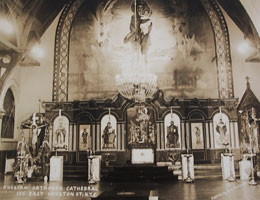 Chapel of St. Cornelius, New York (1931) |
 Russian Orthodox Church, New York (1927) |
Djeneeff’s experience
as an artist in America must have been deeply painful, as few of the jobs
he was offered came near to rivaling his experiences in Russia. Still,
possessed of a strong sense of responsibility for his family, he continued
to seek employment wherever possible. By the late 1920s and into the 1930s,
he accepted a number of important and lucrative commissions for altarpieces
and frescoes in Russian Orthodox, Catholic, and Protestant churches. In
the early 1930s, he succeeded in establishing a reputation as a restorer
of Old Master paintings and was paid handsomely for his efforts. Increasingly,
his name circulated among wealthy New Yorkers, leading to several opportunities
to paint their portraits.
By 1929, his work came to the attention of Marian MacDowell, widow of
the famous composer Edward MacDowell and co-founder of the well-known
artists’ colony in New Hampshire. At her invitation, Djeneeff was a resident
Colonist during the summers of 1929, 1930, and 1931. Colonists were accorded
an opportunity to work and experiment in a supportive environment surrounded
by other creative individuals and undisturbed by day-to-day financial
concerns. Olga’s subsequent letters to Marian MacDowell suggest that these
may have been among Djeneeff’s happiest moments in America. His 1930 portrait
of Mrs. MacDowell is a sensitive portrayal of the woman who enabled him
to experience again some of the satisfactions of earlier times in Saint
Petersburg.